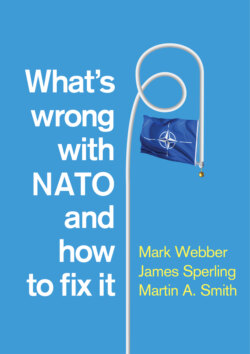Читать книгу What's Wrong with NATO and How to Fix it - Mark Webber - Страница 16
In Summary
ОглавлениеThe approach we take in the remainder of this book, then, is informed by a generally sympathetic view of NATO. We regard the Alliance as indispensable to European and transatlantic security. The international security order would be much worse off if NATO were to systematically fail or to exit global affairs. But while NATO has its virtues, it is also in need of reform. The Alliance has not been resistant to change, and there is a cottage industry of academic and think-tank opinion dedicated to changing it for the better.35 This does not make our study unnecessary. NATO’s importance requires that it be a subject of ongoing scrutiny, and that studies such as ours take on board contemporary challenges and political circumstances. We write this book as major changes impact the international system: the legacy of a Trump presidency that renounced many of the principles of multilateralism; a China and Russia that are pushing back against American claims to global leadership; and a worldwide pandemic that undermines the benefits of global interconnectedness. NATO is, in some ways, touched by all of these global shifts. But to appraise the Alliance, we have focused on a set of problems for which its members are directly responsible and over which, therefore, they can exert some influence. Some of these problems we have already encountered in this chapter. The four we have chosen to structure the book around are significant because they go to the heart of how NATO conducts its affairs and how the Alliance relates to its security and political environment. Tackling them will make a profound difference to NATO’s fortunes. They can be summarized as follows:
task proliferation (the pitfalls of doing too much);
over-reliance on American leadership and a failure of European responsibility;
limits on resources and an inability to obtain an effective allocation of defence capabilities;
a divisive and dangerous relationship with Russia.
We cannot ‘cure’ NATO – like every organization, it will always be found wanting in some way. But we can recommend treatment. The fixes to its problems we see as follows:
doing less but better (task discretion);
rebalancing the responsibilities of leadership toward Europe;
aligning missions with effective and efficiently allocated capabilities;
constructing a realistic partnership with Russia.
Our purpose, then, is clear: to lead NATO toward a healthy recuperation. In this spirit, the book concludes with a summary of how the Alliance ought to prioritize its efforts and so ensure that it remains fit for purpose in the years to come.
